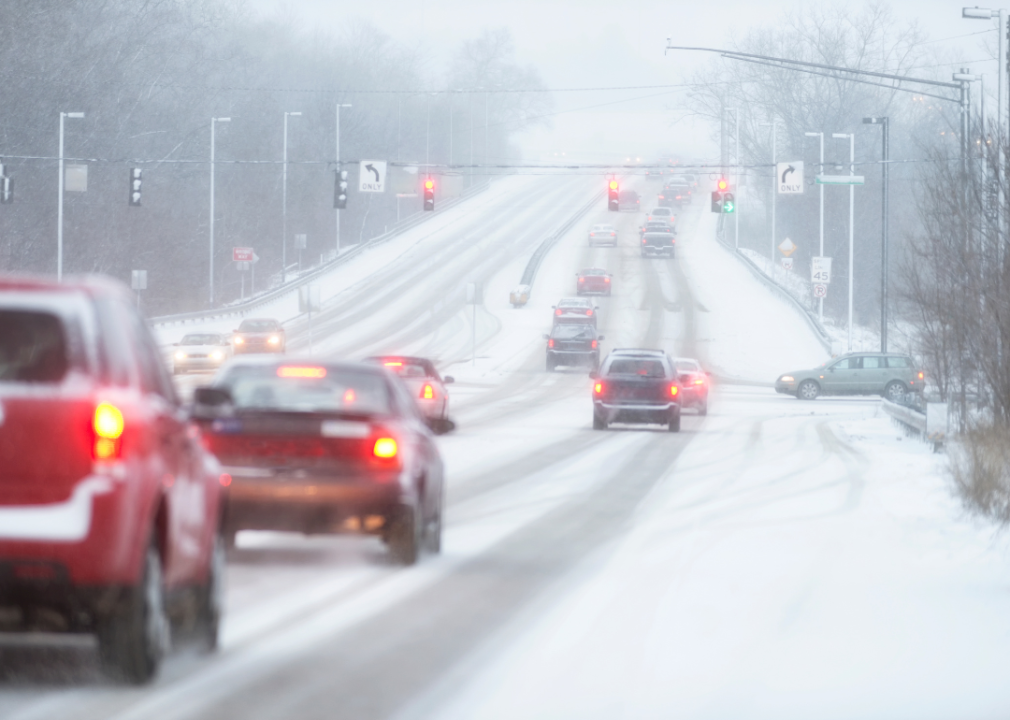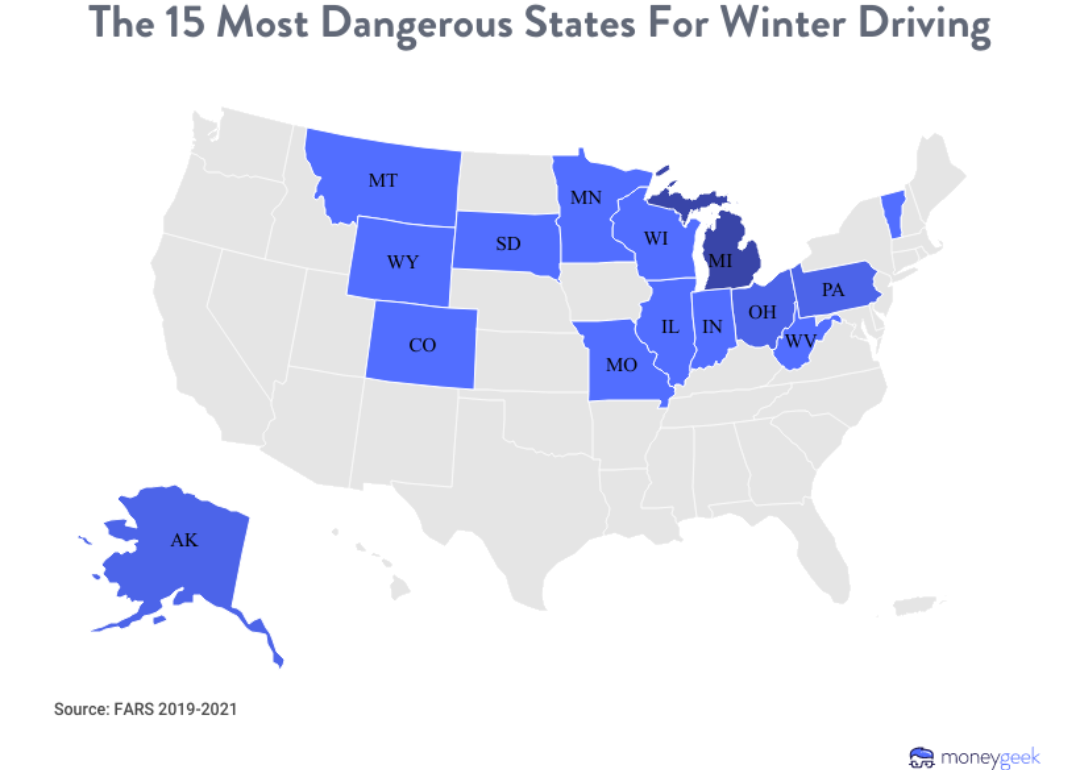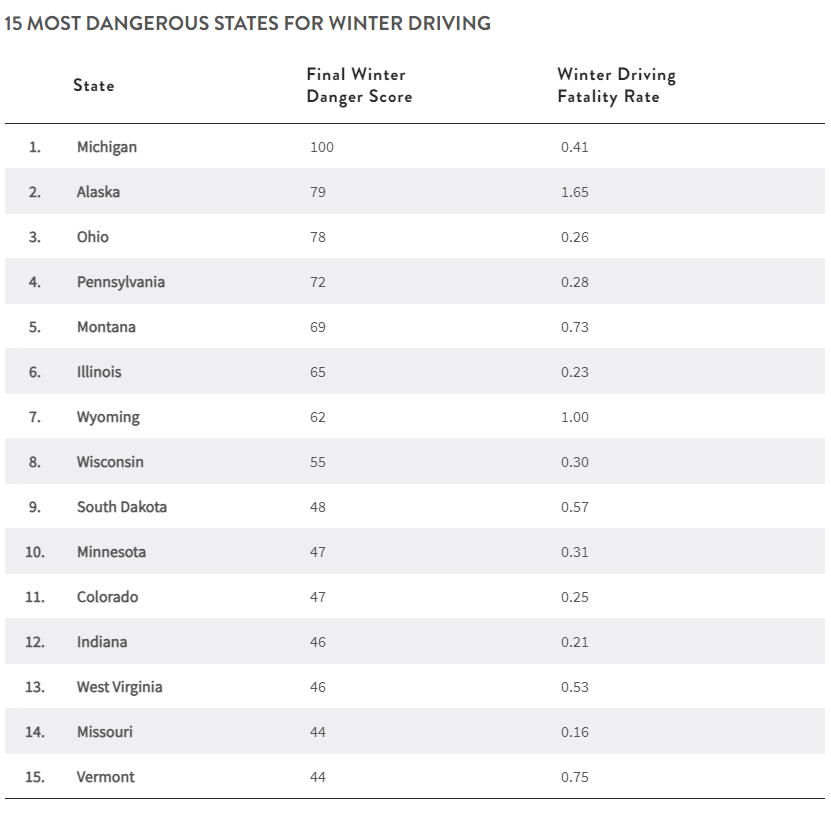These 15 states have the most dangerous winter roads: Here's some tips on staying safe

Canva
These 15 states have the most dangerous winter roads: Here’s some tips on staying safe
A slippery winter road with traffic
The number of fatalities caused by winter auto accidents increased slightly from 374 to 395 from 2020 to 2021. Winter driving continues to be hazardous — especially if you live in one of the states below.
To underscore the importance of safe driving this winter, MoneyGeek analyzed data from the National Highway Traffic Safety Administration’s (NHTSA) Fatality Analysis Reporting System for 2019 to 2021 — the most recent data available — and ranked the most dangerous states for winter driving. We also explored steps drivers can take to prepare for winter weather and stay safe on the road.
The ranking incorporated total fatalities in winter driving conditions, the fatality rate adjusted for vehicle miles traveled in the state, and the state’s score on our ranking of the states with the safest drivers.
We found that when road conditions included sleet, snow, blowing snow, or freezing drizzle, Michigan ranked as the worst state for winter driving overall, while Alaska had the highest winter driving fatality rate.
![]()

MoneyGeek
Key findings
map showing The 15 Most Dangerous States For Winter Driving
- On average, 403 drivers die per year on snowy or icy roads.
- Michigan is the most dangerous state for winter driving, with an average of 39 deaths on the roads every winter. The next most hazardous states for winter driving are Alaska, Ohio, and Pennsylvania.
- Alaska had the highest winter driving fatality rate per billion vehicle miles traveled of any state (1.65), followed by Wyoming (1.00), Vermont (0.75) and Montana (0.73).

MoneyGeek
Most dangerous states for winter driving
a chart showing top 15 most dangerous states for winter driving
While most of us can’t avoid driving in icy and snowy conditions every winter, some states are more dangerous than others.
Our top 15 list doesn’t include some surprising states that experience significant winter weather, like Massachusetts and New Jersey.
Winter driving safety-first measures that could save your life
There are life-saving measures you can take to prepare your vehicle for changing road conditions before the sleet, ice and snow hit your area.
Get a checkup: The worst time for your car to break down is in freezing temperatures, so it’s essential to get your car serviced to check for leaks, worn hoses, and other maintenance items. Your brakes, defroster, heater, and lights should all be working correctly.
Reassess your battery: Battery power drops with the temperature. You want to make sure your battery has enough voltage, amperage, and reserve capacity to start on those cold mornings. If your battery is more than three years old, consider replacing it.
Verify your auto insurance: Ensure that you have the best auto insurance policy to protect you in the event of a weather-related incident. Even if you’re driving responsibly, some accidents are unavoidable if you and another car collide in icy conditions. Call your insurance provider or verify your plan online to double-check your winter weather coverage. Consider comparing car insurance quotes from several providers if you’re in a high-risk winter driving state and your coverage is inadequate.
Top off your windshield wiper fluid: Snowstorms can drain your windshield wiper fluid quickly. Top off your washer reservoir before the first snow hits, and then keep refilling it throughout the season. Late fall is an excellent time to check if those wipers need a replacement.
Look down: Have you checked your floor mats in a while? Are they still in the right place and clear of debris? If not, it’s time to clean up and re-secure them. Improperly installed floor mats can get in your way and prevent you from hitting the gas or brake properly.
Fill up: If you’re always pushing it to the last mile before filling up your gas tank, winter is the time to change that habit. First of all, you don’t want to be stranded in the cold. Secondly, you won’t get as far on that last gallon of gas. According to the Department of Energy, in short-trip city driving, a conventional gasoline car’s gas mileage is about 15% lower at 20 degrees Fahrenheit than it would be at 77 degrees Fahrenheit.
Tread heavy: You should check your tire tread regularly, but in slick conditions, it’s critical. The minimum tread for any road condition is 2/32 of an inch. In winter driving, the more tread, the better. Tire pressure also changes with colder temperatures, so check your owner’s manual to find the correct pressure for your vehicle and add air if needed.
Essential items to keep in your car
Like a good Scout, it’s a good idea to adopt the motto “be prepared” when it comes to winter driving. Keeping emergency supplies in your trunk is a key part of practicing travel safety. Keep the following items in your trunk in case of emergency:
- Spare tire
- Chains
- Snow shovel
- Ice scraper
- Jumper cables
- Sand or kitty litter
- Flashlight
- Blanket
- Water
- Food/snacks
- Cell phone charger
- Medications
Before you leave for a ski vacation or a trip to Grandma’s house, you should plan your travel, checking the weather and road conditions as well as your route. Always give yourself extra time to drive slower.
If you’re traveling with kids, make sure they’re safely buckled in a car seat. While you may want to keep them bundled up in their winter coat, this can interfere with the fit. Consider removing your child’s thick outerwear, buckle them up, and then place blankets or coats over the secure harness.
Methodology
To determine which states are most dangerous for winter driving, MoneyGeek analyzed data from the National Highway Traffic Safety Administration’s (NHTSA) Fatality Analysis Reporting System (FARS) for 2019–2021.
Using FARS data, we calculated each state’s winter driving fatality rate adjusted for vehicle miles traveled, as well as the total winter fatalities in each state. We also utilized the results of a MoneyGeek analysis of the states with the best and worst drivers.
To calculate each state’s Winter Driving Score, we weighted the factors mentioned above. Total Winter Driving Fatalities was given double weight, Winter Driving Fatality Rate was given full weight and Safe Driver Score was given half weight.
Full data set
The data points presented are defined as follows:
- 2023 Rank: The state’s winter driving rank for MoneyGeek’s 2023 study based on its “Final Winter Danger Score,” with a lower rank indicating more dangerous winter driving conditions.
- 2022 Rank: The state’s winter driving rank for MoneyGeek’s 2022 study based on its “Final Winter Danger Score,” with a lower rank indicating more dangerous winter driving conditions.
- Final Winter Danger Score: Total Winter Driving Fatalities, Winter Driving Fatality Rate and Safe Driver Score were each converted to a 100-point scale and weighted. We based the final ranking of states on that score.
- Total Winter Driving Fatalities (2019–2021): Driving fatalities reported by the NHTSA where road conditions included sleet, snow, blowing snow or freezing drizzle for the most recent three years of data 2019–2021. This metric is given double weight in the calculation of the final winter danger score.
- Winter Driving Fatality Rate: The rate of winter driving fatalities per billion vehicular miles traveled. This metric is given full weight in the ranking.
- Safe Driver Score: The final score calculated by MoneyGeek in its rating of the states with the safest and worst drivers. For this analysis, the scores have been scaled to range from 0 to 100, with 100 being the safest. This metric is given half weight.
This story was produced by MoneyGeek and reviewed and distributed by Stacker Media.